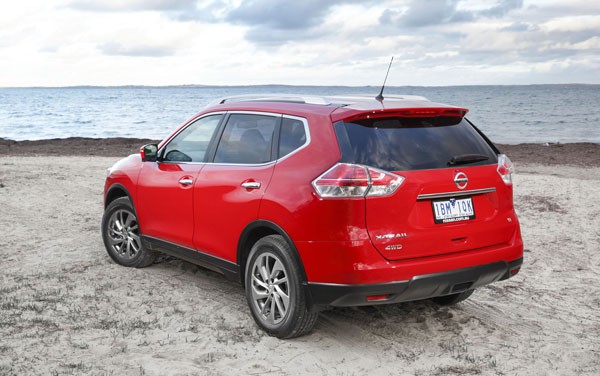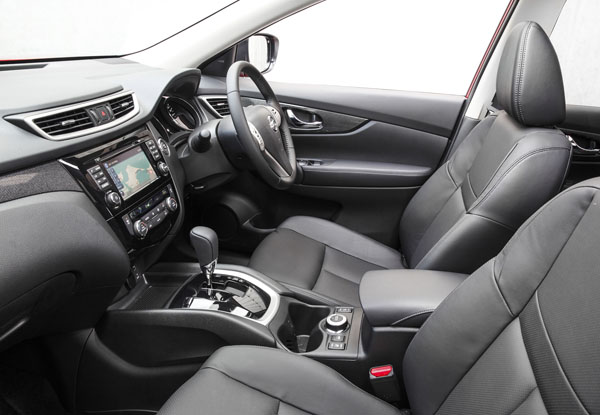 The Nissan X-Trail is a mid-size SUV that has become one of the Japanese maker’s most successful models in Australia – around 140,000 have been sold since 2001.
The Nissan X-Trail is a mid-size SUV that has become one of the Japanese maker’s most successful models in Australia – around 140,000 have been sold since 2001.
Starting life as a compact SUV with leanings towards the bland, the X-Trail has morphed into a mid-size five-seat crossover vehicle incorporating innovative technology and exceptional comfort with the option of seven seats.
Designers have given the SUV a modern street presence by taking cues from the highly successful crossovers Qashqai, Juke and Murano to create a capable, all-weather, family wagon.
 Available in two-wheel and four-wheel drive variants, with the choice of two petrol engines – 2.0-litre and 2.5-litre – the Nissan X-Trail comes to market starting at a competitively priced $27,990, with drive-away for around $31,155. Our test vehicle was the entry-level 2.0 ST six-speed manual. Nissan says turbo-diesel variants are just around the corner.
Available in two-wheel and four-wheel drive variants, with the choice of two petrol engines – 2.0-litre and 2.5-litre – the Nissan X-Trail comes to market starting at a competitively priced $27,990, with drive-away for around $31,155. Our test vehicle was the entry-level 2.0 ST six-speed manual. Nissan says turbo-diesel variants are just around the corner.
STYLING
The X-Trail continues to bulk up with the latest model adding five millimetres in length, 30 mm width, 10 mm height and 75 mm wheelbase.
 Ground clearance, at 210 mm, has been lowered by 5 mm, moving it away from the off-road scene, though a lot of competitors have less clearance than that of the Nissan.
Ground clearance, at 210 mm, has been lowered by 5 mm, moving it away from the off-road scene, though a lot of competitors have less clearance than that of the Nissan.
The X-Trail wagon stands tall on 17-inch alloy wheels, high wheel arches adding to the high-and-mighty character. Nissan signature features include ‘boomerang’ rear lights, structured headlights with LED daytime running lamps and the characteristic D-pillar shape.
Inside, the ST is a mix of premium features which include chrome, geometric metallic and piano black finishes. Seats are covered with hard-wearing stylish black fabric. The ST has seating for up to five adults – a seven-seat option is available in the upper spec ST-L and Ti models – which leave room for Nissan’s unique Divide-N-Hide flexible cargo storage system which comes up with 18 ways to cart stuff.

Two luggage boards allow the area to be split into upper and lower areas in a single-handed move. In its top position, the board can hold up to 10 kg of cargo; in its lowest, maximum load is 75 kg.
Front seats provide continuous support from pelvis to chest, helping to reduce muscular and spinal loads to improve blood flow, reducing fatigue over long periods. Separating the seats is a storage box big enough to take an iPad or 10-inch tablet.
Rear side doors swing out wide (80 degrees) for easy access to the seats and rear cargo space, while the tailgate in the Ti can be automatically opened by a hand swipe of an infra-red sensor above the number plate.
 ENGINES / TRANSMISSIONS
ENGINES / TRANSMISSIONS
Nissan X-Trail is offered with either a 2.0-litre or 2.5-litre four-cylinder petrol engine and with either two-wheel or four-wheel drive.
The 2.0-litre engine, rated at 106 kW of power at 6000 rpm and 200 Nm of torque at 4400 revs, is mated with a six-speed manual transmission and is found in the entry-level X-Trail ST only.
Making use of Nissan’s DIG (Direct Injection Gasoline) technology and twin variable timing control, the combination is designed to deliver fuel economy and solid usable torque. Electric power steering also plays a part in the former, reining in petrol use by avoiding the need for an engine-driven hydraulic pump.
 Nissan claims fuel consumption of 8.2 litres per 100 kilometres on the combined urban / highway cycle with 190 grams of carbon dioxide emitted per kilometre.
Nissan claims fuel consumption of 8.2 litres per 100 kilometres on the combined urban / highway cycle with 190 grams of carbon dioxide emitted per kilometre.
Our test X-Trail ST manual came up with a best figure of 7.1 litres per 100 km; the worst was north of 10 litres per 100 km.
SAFETY
On the safety front, the new X-Trail’s monocoque body design and zone construction with structural front and rear crumple zones is augmented by four-wheel ventilated disc brakes, ABS anti-lock braking system, Electronic Brakeforce Distribution and Brake Assist.

INFOTAINMENT
Nissan opens with an Intelligent Key keyless entry and push-button start. MP3, USB, AUX, Bluetooth telephony, NissanConnect smartphone connectivity follow, while every X-Trail has a reversing camera with guidelines projecting a 130 degree horizontal view on a colour screen on the central dashboard.
Nissan’s Advanced Drive Assist Display use a five-inch LCD screen between the tachometer and speedometer. Steering wheel-mounted controls scroll through functions such as trip computer, fuel consumption information and navigation details, where fitted.
DRIVING
The 2.0-litre engine deals with most driving situations provided the transmission is in the right gear, no complication here thanks to the ST’s slick shifting six-speed manual gearbox. But, lose revs and the ST soon runs out of legs.
When up to speed the X-Trail has little tendency for body roll, even when being punted through fast bends. Here Nissan can be thanked for its Active Ride Control which monitors the road surface for unevenness, which could upset the pitch of the body, and shifts suspension damping to compensate.
Grip in similar situations is optimised by Nissan’s Active Trace Control, which applies braking force to each wheel where necessary. On-board sensors check speed, steering angle, throttle opening and braking effort and brakes wheels as required to reduce understeer, particularly on slippery surfaces.
Both these features give the ST driver a great deal of confidence despite its bulk and two-wheel drive limitations in comparison to all-wheel drive.
SUMMING UP
The breadth of variants and options at highly affordable prices put the new X-Trail at the forefront of the segment. There’s something here for everyone, with the exception of the serious off-road warrior.
AT A GLANCE
MODEL LINE-UP
X-Trail ST 2.0L Manual 2WD $27,990 (Est. driveaway, $31,155)
X-Trail ST 2.5L Xtronic 2WD $30,490 ($33,727)
X-Trail ST 2.5L Xtronic – Seven Seat 2WD $31,580 ($34,853)
X-Trail ST-L 2.5L Xtronic 2WD $36,190 ($39,601)
X-Trail ST-L 2.5L Xtronic – Seven Seat 2WD $37,190 ($40,631)
X-Trail ST 2.5L Xtronic 4WD $33,980 ($37,325)
X-Trail ST-L 2.5L Xtronic 4WD $39,080 ($42,575)
X-Trail Ti 2.5L Xtronic 4WD $44,680 ($48,343)
FEATURES (ST)
Available in 2WD or 4WD
ALL MODE 4×4-i system (4WD only)
2.0-litre petrol four-cylinder engine with 6-speed manual transmission (2WD only)
2.5-litre petrol four-cylinder engine with Next Generation Xtronic CVT with manual mode
5- and 7-seat options (7-seat option available with 2.5l, 2WD CVT only)
17-inch alloy wheels
Daytime running lights
5-inch LCD colour audio display
Rear-view camera Nissan Intelligent Key with keyless entry and push-button start MP3, USB, AUX, Bluetooth telephony, NissanConnect smartphone connectivity
Flexible second-row fold-down seating system: 40/20/40 split format
Divide-N-Hide flexible cargo system (5-seat only)
Cruise control
Rear roof spoiler
SPECIFICATIONS (X-Trail ST 2.0L Manual 2WD petrol engine))
Capacity: 1997 cc
Configuration: Direct Injection Gasoline (DIG)
Bore x Stroke: 84.0 mm x 90.1 mm
Compression Ratio: 11.2:1
Maximum Power: 106 kW @ 6000 rpm
Maximum Torque: 200 Nm @ 4400 rpm
DRIVELINE:
Transmission: 6-speed manual, 2WD
DIMENSIONS, WEIGHT AND CAPACITIES:
Length: 4640 mm
Width: 1820 mm
Height: 1710 mm
Wheelbase: 2705 mm
Track: 1575 mm (front and rear)
Ground clearance: 210 mm
Approach angle: 17.3 deg
Departure angle: 24.8 deg
Tare weight: 1437 kg
Gross vehicle mass: 1945 kg
Fuel Tank Capacity: 60 litres
Towing capacity: 1500 kg (braked); 750 kg (unbraked)
Turning circle: 11.3 m
SUSPENSION AND BRAKES:
Suspension: Independent (front); multilink (rear)
Brakes: Ventilated discs (front and rear). ABS anti-lock with electronic brake force distribution and brake assist, vehicle dynamic control, traction control, hill start assist. Electronic park brake.
Steering: Speed sensitive electric power steering
Wheels: 17-inch alloy, space saver spare
Tyres: 225/60 R17
FUEL CONSUMPTION:
Fuel type: 91 RON unleaded
Combined Cycle (ADR 81/01): 8.2 litres per 100 km. CO2 emissions 190 g / km
GREEN VEHICLE GUIDE RATINGS:
Greenhouse Rating: 5.5 / 10
Air Pollution Rating: 5.5 / 10
STANDARD WARRANTY:
Three years / unlimited kilometres











